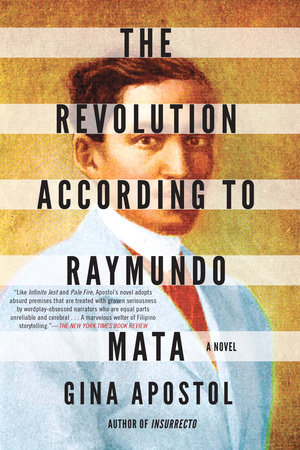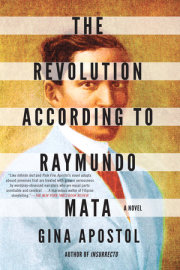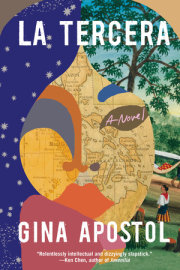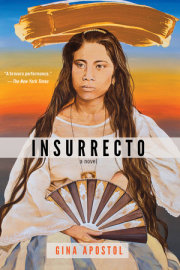Editor’s Preface
I had not read General Mata’s journals when I spoke last year to a Mürkian psychoanalyst about the possibility of hysterical abreactions occurring on a national scale. This was during a lull at a conference at a floating restaurant on Manila Bay (or was it a fish market in Kowloon?—I can’t keep those junkets straight). There was a full moon, and we could see the marble columns of a colonial building nearby—a monstrous wreck that gave the shantytown around it a nasty glamor. The scholar was an unshaved blonde, the kind one often meets at academic conferences. She was expounding on independence movements as “macroscopic examples of aggressivity in the analysand” while she fondled some frangipani and picked through the pectorals of a Peking duck.
It struck me as she manhandled vertebrae and munched on the fronds, or vice versa, that academic blondes are aggressive bores.
To compare our revolution—the crux of our history—to some hysterical patient on a hypothetical couch was just icing on her slanderous cake.
But what did I have to offer her as evidence of the irreducible reality of our history? I knew no scholar, no text, not even a comic book that spoke of the Philippine War of Independence without disturbing solipsism or deeply divided angst. It’s a history that invites neurotics to speak up. It’s no great surprise that it ends up a vulgar patient in obscure neo-Freudian journals.
When the publisher Trina Trono described to me the Raymundo Mata manuscript—an excessive term, perhaps, for the mess she held up in her hands—I have to say I was skeptical. She held up an assortment of unpaginated notes and mismatched sheaves packed in a ratty biscuit tin and stuffed in a tattered medical bag, the edges of the papers curled up in permanent rust.
Then she thrust into my hands another stack, a neatly typed translation, with notes.
But even then.
I was not persuaded.
In my experience, the voice of the revolutionist is clouded by conflicting purposes.
He is vulnerable to the cynicism of a world that by the time he is done has sadly changed.
Our revolution failed.
Let’s face it.
We drove off a Spanish empire that had already given up the ghost then the Americans beat us to a pulp.
They had guns.
We wore slippers.
Who are we kidding?
Everyone acknowledges we got it worse than Vietnam, and the Battle of Manila Bay was way back in 1898.
We lost big time.
Why else do we have postcolonial conferences except to invite everyone to pick at our scabs?
Typically the revolutionist’s memoir emerges when the hero is beyond innocence—when the dream is dead. The gap between the irreducible (the mad flipflop fever, the trauma that cannot be spoken) and the speech that cradles it (unnaturally chronological, with suspicious clarity, and keloids of rancor garnished by footnotes) is only natural.
After all, as the blonde scholar said, and I quote with disgust: “the gap between language and reality is the bane of the human condition.”
Unquote.
However, in the histories of our revolution, this is magnified by the speaker’s own acceptance of his Fall. We’re left with the pathos of which he cannot speak, a rotten trick, if you ask me.
This is the tragic underlying note of all our histories. And so I felt this familiar troubling pain, below the diaphragm, near the liver, when I picked up the tin-can journals of Raymundo Mata, now conveniently stashed into this fine translated state.
My surprise was great as I read on. That the storyteller is, I must admit, flawed, maybe mad, does not diminish my faith in his story.
In fact, his madness amplifies its truth.
Estrella Espejo Quezon Institute and Sanatorium Tacloban, Leyte December 17, 2004 Translator’s Note It was difficult to approach this text with calm as a translator. It is linguistically deranged. One notebook was in spastic code, squiggles and symbols that I think were Japanese characters, hiragana or katakana—I don’t know anything about Japanese. The halting, hallucinatory rendition of those moments arises from the fact that I could barely understand what he was saying.
Interspersed throughout his papers are sheaves that seem to be his private diary, written in the throes of his insomnia (he was well-known for his nocturnalism; there is that sordid legend in his hometown about certain bestial acts he performed in private, in bat caves; I won’t get into that here). These intermittent outpourings are mostly in General Mata’s first language, a curious variant of Tagalog. They portray an admirable grasp of vulgarisms, licentious metaphors, off-color puns. Throughout the diary his prose is remarkably “quotidian,” some call it “rakishly colloquial,” not to mention “peevishly colonial.” As has been said at that last conference in Kauai (or Kowloon, who cares): “he favors loose speech when he writes on loose leaf . . .”
Neat antanaclasis there, Professor Estrella!
But the challenge was to translate the richness of Raymundo’s tongues into singular, common English. I tried my best.
In this way he can sound shockingly modern, with an almost lurid Byronic passion. The lapses in civility that bedevil the text may include my own frugal powers of speech. Trust me, I found faint comfort in the vulgate of our times.
Dr. Diwata Drake refers to some of these passages in her justly celebrated [criminal] monograph on the [purloined] Mata papers (but I believe she has since returned those translations). She discusses the suggestive instances of “frustration, aggressivity, regression—the triad of resistances that mark revolutionary pathology,” but really, if you think about it, he was probably drunk.
The original papers are not pristine. Some sections have been lost forever. A few remnants are decidedly fantastical, destined for the dustbin: e.g., a set of tyrannical memos that may be direct transliterations from an ancient Indo-Malayan script that for some reason exists otherwise only on a copper jug dug up in Palawan, or Palau.
Curiously, critics from Yogyakarta have both denounced the script as inauthentic as well as demanded that jug’s return.
At the same time it seems that Raymundo’s manuscript is not entirely innocent of transgressions on the Arabic, though mainly in regard to suspect nouns, e.g., odd mutations on terms for grape derivatives, also of words for “fig.” Raymundo has spatterings of Waray (errant strains from his unknown mother?—a tragic story
1), pidgin and random Cebuano, as well as nominal, surly Ilocano. Elsewhere cryptic notes of Cavite-Chabacano occur, fruity, with a slightly buttery-chocolate taste, good for pork but not fish. In short, a grand Babel of the Filipino soul marinates in the manuscript like some wet mix of adobo, pancit, and lugaw.
2 3 It’s important to note that his Tagalog, erudite as it is (especially when he deals with anatomy), is irreversibly contaminated by the Spanish.
General Mata’s use of Spanish must be addressed if any reader is to appreciate this text at all. In 1896, as we all know, Mother Spain was no welter of fabulous ambiguity. Spain was the tyrant of the islands.
Since 1521.
It’s true that chunks of conservatism regularly fell off like rotting teeth from the obsolete dentures of the King of Spain. And yes, Spain had commanded the islands by indirection, if not misdirection, via the Viceroy of Mexico, for three hundred seventy-five years—give or take a few months of British occupation of Manila and Cavite (coincidentally, twin rebel
loci of our hero’s childhood).
The worst were the friars—the actual rulers of the islands. At times the only Spaniards in far-flung parishes, the feeble frailes kept feeling like Kings.
Sure, some note the religious orders did have their de las Casas
4 5 6 7 8 types: missionary warriors or navigator-scientists, third sons with ambition in their hearts.
In sum: after 1492, when they finally kicked out the Jews, the dregs of Spain’s anti-Semitic soldiers found themselves with nothing to do (some were even Jewish). So says the Basque historian Salvador de Madariaga. Many of them took on the cassock and found their notions of grandeur satisfied in a coconut and banana-strewn archipelago, filled with ripe papayas to their hearts’ content. They learned the island languages but kept their own tongue. Dictionaries of Chabacano and Pangalatoc and Waray abound, scribbled by nosy, lonesome friars, when they weren’t torturing the natives to fetch them water, make them paper flowers, or sculpt their wooden Christs. Not to mention indulging in bedroom affairs (yes, yes, Professor Estrella: they were scalawags and rapists, for whom the above papayas are only metonyms for their ripe lusts!). When the Filipinos came into their own as people of the faith and wanted a piece of the sacristy for themselves—demanding to become priests of their own parishes—hell, no, said the friars. When Filipinos wanted to own their own lands, hell, no, said the friars. When Filipinos began to write their own books, oh no, you don’t, they said.
It was the
frailes who agitated to condemn those fin-de-siècle writers and local printers and native priests and mestizo rebels to death.
However, rebellion in this pelagic not-yet-nation was not so peculiar.
For instance: in 1896, the Filipino rebels’ nemesis, Miguel Primo de Rivera, at the time a twenty-six-year-old colonel of the Spanish army in Manila, went on to become the dictator of Spain (1923-1930)—clearly, a premodern type.
Miguel Primo de Rivera became the jailer of the existentialist philosopher Miguel de Unamuno and antecedent of the historical fiasco Francisco Franco. Primo de Rivera turned out to be a thoughtless crusader not only against the insurrectos, as Filipinos were indiscriminately called by the katsila,
9 a.k.a.
coño (as Filipinos indiscriminately called the katsila)—but also against his own people, the Spaniards. This comes as no surprise except to all of us who could care less about history.
Should it comfort Filipinos to know that an enemy of their liberators was direct progenitor of a whole bloodline of fascists, founders of the Falangist Party, so that Filipino revolutionaries are linked to saintly anarchists, radical victims, and lovely socialists such as George Orwell, not to mention impotent dilettantes, such as Hemingway?
It should, but this late in history—
que se joda?,
10 as my mother would say.
And so it is that the nineteenth-century Spanish of this memoir’s heroes has about it the romantic fervor of a steamy liaison with a voluptuous mistress—a whole sauna bath of soggy metaphors. Raymundo Mata’s prose possesses the Spanish of incipient
amor: faintly medieval, awash in cultish linguistic sulfur. The academic language of the revolutionaries marries anarchic spleen with romantic chivalry, giving birth to deeply troubling progeny—that is, anti-clerical Masons who went to church.
11 It is not necessarily to my complete dissatisfaction that the rigors of history have divorced the country from the Spanish
lengua.
12 13 But some regret what was lost in that linguistic divide, namely, a rather large bulk of the nation’s patrimony, maybe fifty kilos’ worth.
As for the particulars of the Spanish begotten in Raymundo Mata, or misbegotten as the case may be: as we all know now, since Dr. Diwata Drake, late of Magdalen College in Oxford, now gallivanting around the globe, already blabbed all about it before we went to press (but I shall not expound on that here, as the klepto lawsuit is ongoing, I have nothing to do with it)—the general was brought up in a priest’s kumbento, in the home of his uncle, an island-born half-katsila of the cassock, committed to Christ.
True, the uncle, called
Tio U. in this coded diary, seems to have been only a coadjutor, a lowly assistant priest. Who knows what axes this unpromoted man had to grind? He and his brother, Raymundo’s father, were mestizo
coño—sons of a Basque policeman, of the Guardia Civil, and his lowland wife, a businesswoman, specifically, a vendor of lamp-oil. The lowly status of Raymundo’s uncle among the Spanish religious orders does make scattered pieces of faith in the papers even more affecting—signs of a nephew’s filial piety: e.g., Raymundo Mata’s litany to the Latin names of Mary (Entry #12), and so on.
But more interesting: the boy was educated in the theater.
From birth, Raymundo Mata was immersed in the world of make-believe.
His father, Jorge Raymundo Mata, a.k.a.
el genio Jote, was the priest Tio U.’s beloved wastrel brother—an itinerant actor in provincial melodramas.
Who ended up a bandit.
Sad, but true.
1 Oh the transgressions, you can call them that, on the life of his sad mother! The late lamented Leyteña, Maria Tarcela, or is it Marcela—whom Caviteños fail to acknowledge as the crux—the heart—the haunting ghost in young Raymundo’s story—as is the case of all Filipinos and their mothers, if you think about it, really. (Estrella Espejo, Quezon Institute and Sanatorium, Tacloban, Leyte)
2 Ah how I remember the luxury of lugaw as a kid, whenever I was sick in bed and stayed home from school—my mom’s specialty, flavored with cinnamon and molasses. Those are the moments I remember most about my robust nanay, maker of sinanlag and ladler of hipon (not that bland Tagalog bagoong!)—her own art, mix of shrimp and chili, with the occult taste of the sea and the earthy residue of baptismal fonts! Not this damned watery vileness—this cheap, mealy mash, this glum slime—that the nurses keep giving me! I have fragility of the nerves, not gum disease: can’t I get real, decent rice, at least! (Estrella Espejo, ditto)
3 Fragile nerves! You’re a spastic imbecile. I mean, a special ambassador. (Dr. Diwata Drake, Anaheim, California)
4 Really, Ms Translator? Who are you kidding—we had no Bartolome de las Casas in our sucesos, no eloquent curser of the conquistadores. We had Padre Damaso and Padre Salvi. Scalawags! Demonio! Spoilers of women and faith! Whose side are you on, Ms. Translator?? (Estrella Espejo, ditto)
5 Uuuh. Professor Estrella: Padre Damaso and Padre Salvi were fictional characters created by the hero-novelist Rizal. Though, true: Spanish priests were the devil. And that is the summa of Spanish history in the Philippines. (Trans. Note)
6 True! Father Damaso and Father Salvi are brain-children of Rizal, just like the country! Ah, how Rizal portrayed the truth. Just look at the demon friars’ spawn, the deathly pale mestizos all around us! Diyos ko ‘day! A ghostly people created in ungodly lust! Though I do like their cochinillo, t.b.h. (Estrella Espejo, ditto)
7 Uuuuh. Rizal was a mestizo, Professor Estrella? (Trans. Note)
8 Ah, there’s the rub. That the country arises from fiction, but this makes the demons no less true. Such is the fate of fantastic Nation. (Dr. Diwata Drake, Copenhagen, Denmark)
9 Filipinos used the term katsila, or, in the orthography of the time, kachila, to refer to both the Spanish person (Castilian/castellano) and the Spanish tongue. Even today, katsila types in Manila are simply called, without irony, coño. (Trans. Note)
10 Do all mothers have an unconditioned way with words to show their unconditional love, Mimi C.? Que se joda. A pungent phrase from my childhood. For my mom, may she rest in peace, that meant, I do not care, do as your conscience sees fit! And so I would learn not to disobey—except in my dreams. Later I learned the words meant something else. In this way my mother condemned me, nga birat ka, or silibanco pa man, buot dida, inday, in loving tones that made me buotan: that is, a beloved though bruised daughter. Ave Maria! (Estrella Espejo, ditto)
11 Ah, but is it not so that the cases of our affection are also matters of our split [mis]identifications, Professor Estrella? The above church-going anti-clerical Masons are specimens of humanity, are they not, just like our contemporary Filipinos: who are homophobic gay-lovers and matriarchal misogynists? As a wise proverb of an otherwise secular genius goes: That he is a trinity tells us even God is empty—a divided self [Claro Mürk, Proverbs III]. (Dr. Diwata Drake, Manila, Philippines)
12 A colonial dish of ox tongue, made by my mother with tons of peppercorn and olives. Cooks from other regions—and they know who they are—ruin it with sugar. Shame on them! (Estrella Espejo, ditto)
13 Yes, Estrella, one may call that lengua a suspect yet indivisible part of the Filipino stew simmering in the tongue—smothered with soy sauce and garlic, braised later in an American brew: English. (Dr. Diwata Drake, Manila, Philippines)
Copyright © 2021 by Gina Apostol. All rights reserved. No part of this excerpt may be reproduced or reprinted without permission in writing from the publisher.











